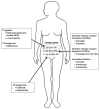Hormone response in ovarian cancer: time to reconsider as a clinical target?
- PMID: 23045324
- PMCID: PMC3696394
- DOI: 10.1530/ERC-12-0175
Hormone response in ovarian cancer: time to reconsider as a clinical target?
Abstract
Ovarian cancer is the sixth most common cancer worldwide among women in developed countries and the most lethal of all gynecologic malignancies. There is a critical need for the introduction of targeted therapies to improve outcome. Epidemiological evidence suggests a critical role for steroid hormones in ovarian tumorigenesis. There is also increasing evidence from in vitro studies that estrogen, progestin, and androgen regulate proliferation and invasion of epithelial ovarian cancer cells. Limited clinical trials have shown modest response rates; however, they have consistently identified a small subset of patients that respond very well to endocrine therapy with few side effects. We propose that it is timely to perform additional well-designed trials that should include biomarkers of response.
Figures
References
-
- Aabo K, Pedersen AG, Haid I, Dombernowsky P. High-dose medroxyprogesterone acetate (MPA) in advanced chemotherapy-resistant ovarian carcinoma: a phase II study. Cancer Treatment Reports. 1982;66:407–408. - PubMed
-
- Ahlgren JD, Ellison NM, Gottlieb RJ, Laluna F, Lokich JJ, Sinclair PR, Ueno W, Wampler GL, Yeung KY, Alt D, et al. Hormonal palliation of chemoresistant ovarian cancer: three consecutive phase II trials of the Mid-Atlantic Oncology Program. Journal of Clinical Oncology. 1993;11:1957–1968. - PubMed
-
- Akahira J, Suzuki T, Ito K, Kaneko C, Darnel AD, Moriya T, Okamura K, Yaegashi N, Sasano H. Differential expression of progesterone receptor isoforms A and B in the normal ovary, and in benign, borderline, and malignant ovarian tumors. Japanese Journal of Cancer Research. 2002;93:807–815. doi:10.1111/j.1349-7006.2002. tb01323.x. - PMC - PubMed
-
- Albanito L, Madeo A, Lappano R, Vivacqua A, Rago V, Carpino A, Oprea TI, Prossnitz ER, Musti AM, Andò S, et al. G protein-coupled receptor 30 (GPR30) mediates gene expression changes and growth response to 17β-estradiol and selective GPR30 ligand G-1 in ovarian cancer cells. Cancer Research. 2007;67:1859–1866. doi:10.1158/0008-5472.CAN-06-2909. - PubMed
-
- Anderson GL, Judd HL, Kaunitz AM, Barad DH, Beresford SA, Pettinger M, Liu J, McNeeley SG, Lopez AM, Women's Health Initiative Investigators Effects of estrogen plus progestin on gynecologic cancers and associated diagnostic procedures: the Women's Health Initiative randomized trial. Journal of the American Medical Association. 2003;290:1739–1748. doi:10.1001/jama.290.13.1739. - PubMed
Publication types
MeSH terms
Substances
Grants and funding
LinkOut - more resources
Full Text Sources
Medical


